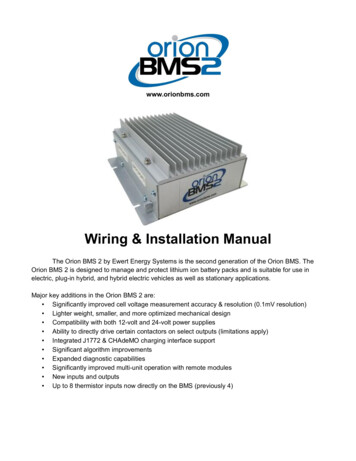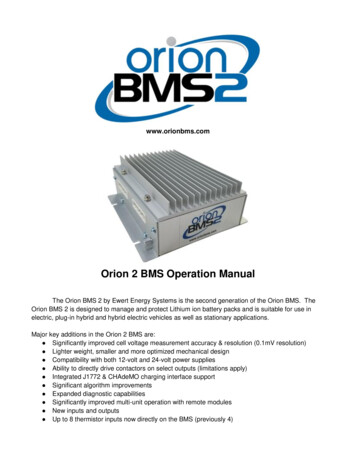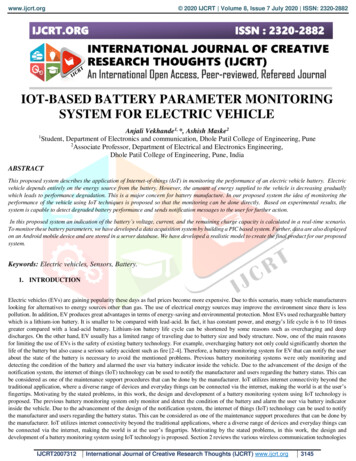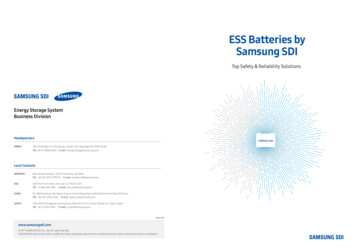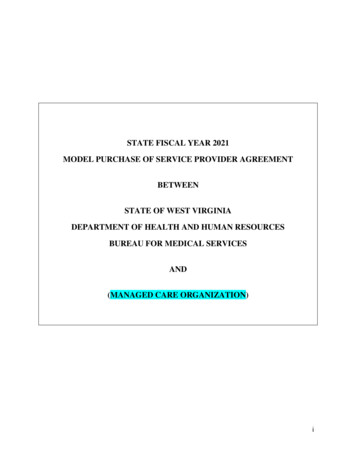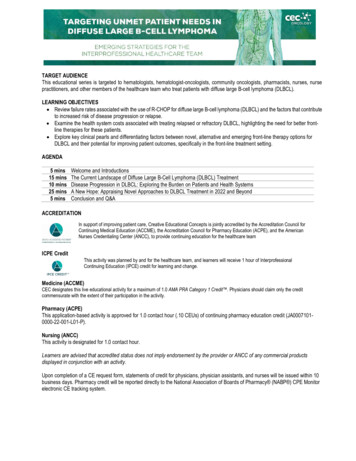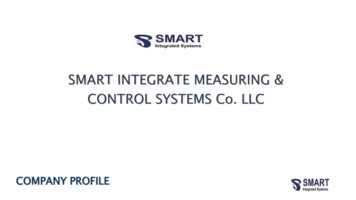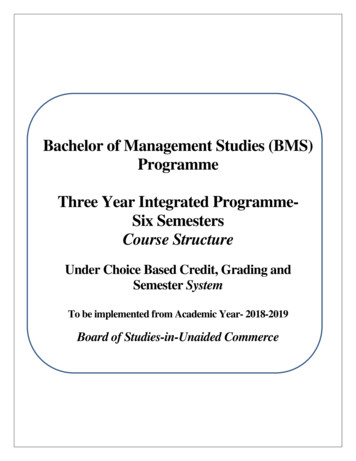
Transcription
Bachelor of Management Studies (BMS)ProgrammeThree Year Integrated ProgrammeSix SemestersCourse StructureUnder Choice Based Credit, Grading andSemester SystemTo be implemented from Academic Year- 2018-2019Board of Studies-in-Unaided Commerce
Bachelor of Management Studies (BMS) ProgrammeUnder Choice Based Credit, Grading and Semester SystemCourse StructureFYBMS(To be implemented from Academic Year- 2018-2019)CoursesCode1Semester ICreditsCoursecode03SIUBMS21SIUBMS12Elective Courses (EC)Introduction toFinancial AccountsBusiness Law03SIUBMS13Business Mathematics03SIUBMS 1122ASIUBMS142BSIUBMS151Ability Enhancement Courses(AEC)Ability EnhancementCompulsory Course (AECC)Business03Communication - I*Skill Enhancement Courses(SEC)Foundation Course-I02Semester II03SIUBMS22Elective Courses (EC)Introduction to CostAccounting – I *Industrial LawSIUBMS23Business 6SIUBMS17Business Economics-I03SIUBMS27 Principles ofManagementTotal Credits32003Ability Enhancement Courses(AEC)Ability Enhancement CompulsoryCourse (AECC)Business03Communication -II**Skill Enhancement Courses(SEC)Foundation Course -II02Core Courses (CC)Foundation of HumanSkills3CreditsCore Courses (CC)Principles of MarketingTotal Credits* Business Environment is replaced with Introduction to Cost Accounting-I030320
Bachelor of Management Studies (BMS) ProgrammeUnder Choice Based Credit, Grading and Semester SystemCourse StructureSYBMS(To be implemented from Academic Year- 2018-2019)CoursesCourseSemester IIICreditsSemester IVCreditsCodecodeElective Courses (EC)Elective Courses (EC)11(Marketing or Finance)(Marketing or Finance)Marketing ElectivesMarketing ElectivesSIUBMS31MConsumer BehaviourSIUBMS32M Advertising0303Finance ElectivesSIUBMS41M Integrated MarketingCommunicationSIUBMS42M Rural MarketingEquity & Debt Market03SIUBMS41FSIUBMS32FCorporate BMS36SIUBMS3703Finance ElectivesSIUBMS31F203Ability Enhancement Courses(AEC)Ability EnhancementCompulsory Course (AECC)Information03Technology inBusiness Management-I*Skill Enhancement Courses(SEC)Foundation Course –02III (EnvironmentalManagement)Core Courses (CC)Business Planning &EntrepreneurialManagementAccounting forManagerial DecisionsStrategic ManagementTotal 3SIUBMS4720Strategic CostManagementAuditing0303Ability Enhancement Courses(AEC)Ability EnhancementCompulsory Course (AECC)Information Technology03in BusinessManagement-II**Skill Enhancement Courses(SEC)Foundation course-IV02(Ethics & Governance)Core Courses (CC)Business Economics-IIBusiness ResearchMethodsProduction & TotalQuality ManagementTotal Credits03030320
Bachelor of Management Studies (BMS) ProgrammeUnder Choice Based Credit, Grading and Semester SystemCourse StructureTYBMS(To be implemented from Academic Year- 2018-2019)CoursesCodeSemester VCreditsElective Courses (EC)(Marketing or Finance)Marketing ElectivesCoursecodeSemester VICreditsElective Courses (EC)(Marketing or Finance)Marketing Electives11SIUBMS51M Services Marketing03SIUBMS61M Brand Management03SIUBMS52M E-Commerce &03SIUBMS62M Retail Management0303SIUBMS63M International0303MarketingSIUBMS64M Media Planning &Management03Digital MarketingSIUBMS53M Sales & DistributionManagementSIUBMS54M CustomerRelationshipManagementFinance ElectivesFinance ElectivesSIUBMS51FInvestment Analysis& PortfolioManagementSIUBMS52F Financial Accounting03SIUBMS61FInternational Finance0303SIUBMS62FProject Management03SIUBMS53FRisk Management03SIUBMS63FSIUBMS54FDirect Taxes032SIUBMS552ASIUBMS56Core Courses (CC)Logistics & SupplyChain ManagementStrategic FinancialManagementSIUBMS64F Indirect Taxes204Ability Enhancement Course(AEC)04CorporateSIUBMS652ASIUBMS660303Core Courses (CC)Operation Research04Ability Enhancement Course(AEC)04Project WorkCommunication &Public RelationsTotal Credits20Total Credits20
Revised SyllabusOfBachelor of Management Studies (BMS)ProgrammeFirst YearSemester I and IIUnder Choice Based Credit, Grading andSemester System(To be implemented from Academic Year- 2018-2019)Board of Studies-in-Unaided Commerce
Bachelor of Management Studies (BMS) ProgrammeUnder Choice Based Credit, Grading and Semester SystemCourse Structure(To be implemented from Academic Year- 2018-2019)Semester ICourses Code1Semester ICreditsElective Courses (EC)SIUBMS11Introduction to Financial Accounts03SIUBMS12Business Law03SIUBMS13Business Mathematics0322ASIUBMS142BSIUBMS153Ability Enhancement Courses (AEC)Ability Enhancement Compulsory Course (AECC)Business Communication - I03*Skill Enhancement Courses (SEC)Foundation Course - I02Core Courses (CC)SIUBMS16Foundation of Human Skills03SIUBMS17Business Economics-I03Total Credits20
Revised Syllabus of Courses of Bachelor of Management Studies(BMS) Programme at Semester Iwith Effect from the Academic Year 2018-2019Elective Courses (EC)SIUBMS11 Introduction to Financial AccountsModules at a GlanceSr.No.No. ofLecturesModules1Introduction152Accounting Transactions153Depreciation Accounting & Trial Balance154Final Accounts15Total60Learning Objective:The course is intended to introduce the basic theory, concepts and practice offinancial accounting and to enable the students to understand informationcontained in the published financial statements of companies and otherorganisations.
Sr. No.1Modules / UnitsIntroduction Meaning and Scope of Accounting: Need and development, definition: BookKeeping and accounting, Persons interested in accounting, Branches of accounting,Objectives of accounting2 Accounting principles: Introductions to Concepts and conventions.Introduction to Accounting Standards: Meaning and Scope)AS 1 : Disclosure to Accounting PoliciesAS 2 :- Stock ValuationAS 6: Depreciation Accounting.AS 9: Revenue Recognition.AS 10: Accounting For Fixed Assets. International Financial Reporting Standards (IFRS):Introduction to IFRSIAS-1:Presenttion of Financial Statements (Introductory Knowledge)IAS-2:Inventories (Introductory Knowledge)Accounting Transactions Accounting transactions: Accounting cycle, Journal, Journal proper, Openingand closing entries, Relationship between journal & ledger: Rules regardingposting: Trial balance: Subsidiary books (Purchase, Purchase Returns, Sales, SalesReturns & cash book –Triple Column), Bank Reconciliation Statement. Expenditure: Classification of Expenditure- Capital, revenue and DeferredRevenue expenditure Unusual expenses: Effects of error: Criteria test. Receipts: Capital receipt, Revenue receipt, distinction between capital receiptsand revenue receipts.Profit or Loss: Revenue profit or loss, capital profit or loss3Depreciation AccountingDepreciation accounting: Practical problem based on depreciation using SLMand RBM methods. (Where Provision for depreciation Account not maintained).4FINAL ACCOUNTS Introduction to Final Accounts of a Sole proprietor. Rectification of errors. Manufacturing Account, Trading Account, Profit and Loss Account andBalance Sheet. Preparation and presentation of Final Accounts in horizontal format
Revised Syllabus of Courses of Bachelor of Management Studies(BMS) Programme at Semester Iwith Effect from the Academic Year 2018-2019Elective Courses (EC)SIUBMS12 Business LawModules at a GlanceSr.No.No. ofLecturesModules1Contract Act, 1872 & Sale of Goods Act, 1930152Negotiable Instrument Act, 1981 & Consumer Protection Act,1986153Company Law154Intellectual Property Rights(IPR)15Total60Learning Objectives: To understand the basic concept of agreement & contract. To understand the relationship between the seller & buyer under the sale ofgoods Act. To understand relationship between banker & customer under negotiation ofgoods act 1881.
Sr. No.Modules / Units1Contract Act, 1872 & Sale of Goods Act, 19302 Contract Act,1872: Essential elements of Contract; Agreement and Contract –Capacity to Contract, free consent, consideration, lawful objects/consideration, Breach of contract. Remedies for breach of Contract. Sale of Goods Act,1930: Scope of Act, Sale and Agreement to sell, essential ofa valid Sale Contract – Conditions and warranties – Implied Condition andwarranties, Rights of an unpaid seller.Negotiable Instrument Act, 1981 & Consumer Protection Act, 19863Negotiable Instrument Act,1981: Introduction of Negotiable Instruments – Characteristics of negotiableinstruments, Promissory note, Bills of exchange, Cheque, Dishonour ofCheque.Consumer Protection Act, 1986: Objects of Consumer Protection- Introduction of Consumers, who isconsumer? Meaning of the words ―Goods and services‖ – Meaning ofthewords ―Defects and Deficiencies of goods and services‖ Consumer disputesand Complaints.Company Law4 Company Law: What is company? – Incorporation of company – MOA, AOA,Prospectus, Meetings, Meaning of transfer and transmission of sharesIntellectual Property Rights (IPR) IPR definition/ objectives Patent definition. What is patentable? What is not patentable? Invention Andits Attributes, Inventors and Applications Trademarks, definition, types of trademarks, infringement and passing off. Copy right definition and subject in which copy right exists, Originality,Meaning and Content, Authors and Owners, Rights and Restrictions. Geographical indications (only short notes)
Revised Syllabus of Courses of Bachelor of Management Studies(BMS) Programme at Semester Iwith Effect from the Academic Year 2018-2019Elective Courses (EC)SIUBMS13 Business MathematicsModules at a GlanceSr.No.ModulesNo. ofLectures1Elementary Financial Mathematics152Matrices and Determinants153Derivatives and Applications of Derivatives154Numerical Analysis [Interpolation]15Total60Learning Objectives: Understanding basic terms in the areas of business calculus and financialmathematics Independently solving of business problems.
Sr. No.1Modules / UnitsElementary Financial Mathematics Simple and Compound Interest: Interest compounded once a year, more thanonce a year, continuous, nominal and effective rate of interest Annuity-Present and future value-sinking funds Depreciation of Assets: Equated Monthly Installments (EMI)- using flatinterest rate and reducing balance method. Functions:Algebraic functions and the functions used in business andeconomics, Break Even and Equilibrium point. Permutation and Combination: (Simple problems to be solved with thecalculator only)2Matrices and Determinants Matrices: Some important definitions and some important results. Matrixoperation (Addition, scalar multiplication , matrix multiplication, transpose of amatrix) Determinants of a matrix of order two or three: properties and results ofDeterminants Solving a system of linear equations using Cramer‘s rule Inverse of a Matrix (up to order three) using ad-joint of a matrix and matrixinversion method Case study: Input Output Analysis3Derivatives and Applications of Derivatives Introduction and Concept: Derivatives of constant function, logarithmicfunctions, polynomial and exponential function Rules of derivatives: addition, multiplication, quotient Second order derivatives Application of Derivatives: Maxima, Minima, Average Cost and MarginalCost. Total revenue, Marginal revenue, Average revenue. Average and Marginalprofit. Price elasticity of demand4Numerical Analysis [Interpolation] Introduction and concept: Finite differences – forward difference operator –Newton‘s forward difference formula with simple examples Backward Difference Operator. Newton‘s backward interpolation formula withsimple examples
Revised Syllabus of Courses of Bachelor of Management Studies(BMS) Programme at Semester Iwith Effect from the Academic Year 2018-2019SIUBMS14 Business Communication - IModules at a GlanceSr.No.ModulessNo. ofLectures1Theory of Communication152Obstacles to Communication in Business World153Business Correspondence154Language and Writing Skills15Total60Learning Objectives:After completion of the syllabus, students should be able to: Apply appropriate communication skills across setting, purposes, andaudiences. Demonstrate knowledge of communication theory and application. Practice critical thinking to develop innovative and well-foundedperspectives related to the students emphases. Build and maintain healthy and effective relationships. Use technology to communicate effectively in various settings andcontexts. Demonstrate appropriate and professional ethical behavior.
Sr. No.1Modules / UnitsTHEORY OF COMMUNICATIONConcept of Communication: Meaning, Definition, Process, Need,FeedbackEmergence of Communication as a key concept in the Corporate andGlobal worldImpact of technological advancements on CommunicationChannels and Objectives of Communication: ChannelsFormal and Informal- Vertical, Horizontal, Diagonal, GrapevineObjectives of Communication: Information, Advice, Order and Instruction,Persuasion, Motivation, Education,Warning, and Boosting the Morale ofEmployees(A brief introduction to these objectives to be given)Methods and Modes of Communication:Methods: Verbal and Nonverbal, Characteristics of Verbal CommunicationCharacteristics of Non-verbal Communication, Business EtiquetteModes: Telephone and SMS Communication 3 (General introduction to Telegramto be given) Facsimile Communication [Fax] Computers and E- communication Video and Satellite Conferencing2OBSTACLES TO COMMUNICATION IN BUSINESS WORLDProblems in Communication /Barriers to Communication:Physical/ Semantic/Language / Socio-Cultural / Psychological / Barriers, Ways toOvercome these BarriersListening: Importance of Listening Skills, Cultivating good Listening Skills – 4Introduction to Business Ethics:Concept and Interpretation, Importance of Business Ethics, Personal Integrity atthe workplace, Business Ethics and media, Computer Ethics, Corporate SocialResponsibility3BUSINESS CORRESPONDENCETheory of Business Letter Writing:Parts, Structure, Layouts—Full Block, Modified Block, Semi - Block Principles ofEffective Letter Writing, Principles of effective Email Writing,Personnel Correspondence:Statement of Purpose, Job Application Letter and Resume, Letter of Acceptance ofJob Offer, Letter of Resignation[Letter of Appointment, Promotion and Termination, Letter of Recommendation(to be taught but not to be tested in the examination)]4LANGUAGE AND WRITING SKILLSLanguage and writing skillsCommercial terms used in business communication
Paragraph Writing:Developing an idea, using appropriate linking devices, etcCohesion and Coherence, self-editing, etc [Interpretation of technical data,Composition on a given situation, a short informal report etc.]Activities Listening Comprehension Remedial Teaching Speaking Skills: Presenting a News Item, Dialogue and Speeches Paragraph Writing: Preparation of the first draft, Revision and Self – Editing,Rules of spelling.Reading Comprehension: Analysis of texts from the fields of Commerce andManagementImportance of social media in communication: use of social mediaFacebook, twitter, whatsapp, telegram etc. Applications and their use inspreading messages in formal and informal way.0.
Revised Syllabus of Courses of Bachelor of Management Studies(BMS) Programme at Semester Iwith Effect from the Academic Year 2018-2019Skill Enhancement Courses (SEC)SIUBMS15 Foundation Course -IModules at a GlanceSr.No.ModulesNo. ofLectures1Overview of Indian Society052Concept of Disparity‐ 1103Concept of Disparity‐2104The Indian Constitution105Significant Aspects of Political Processes10Total45Learning Objectives: To impart knowledge on multicultural diversity of Indian Society. To give the overview of Indian Constitution. To explore the reasons for disparity arising out of gender inequalities. To examine inequalities due to caste system and intergroup conflicts arisingout of communalism.
Sr. No.Modules / Units1Overview of Indian SocietyUnderstand the multi-cultural diversity of Indian society through its demographiccomposition: population distribution according to religion, caste, and gender;Appreciate the concept of linguistic diversity in relation to the Indian situation;Understand regional variations according to rural, urban and tribal characteristics;Understanding the concept of diversity as difference2Concept of Disparity‐ 1Understand the concept of disparity as arising out of stratification and inequality;Explore the disparities arising out of gender with special reference to violenceagainst women, female foeticide (declining sex ratio), and portrayal of women inmedia;Appreciate the inequalities faced by people with disabilities and understandthe issues of people with physical and mental disabilities3Concept of Disparity‐2Examine inequalities manifested due to the caste system and inter-group conflictsarising thereof; Understand inter-group conflicts arising out of communalism;Examine the causes and effects of conflicts arising out of regionalism andlinguistic differences4The Indian ConstitutionPhilosophy of the Constitution as set out in the Preamble; The structure of theConstitution-the Preamble, Main Body and Schedules; Fundamental Duties of theIndian Citizen; tolerance, peace and communal harmony as crucial values instrengthening the social fabric of Indian society; Basic features of the Constitution5Significant Aspects of Political ProcessesThe party system in Indian politics; Local self-government in urban and ruralareas; the 73rd and 74th Amendments and their implications for inclusive politics;Role and significance of women in politics
Revised Syllabus of Courses of Bachelor of Management Studies(BMS) Programme at Semester IWith Effect from the Academic Year 2018-2019Core Courses (CC)SIUBMS16 Foundation of Human SkillsModules at a GlanceSr.No.ModulesNo. ofLectures1Understanding of Human Nature152Introduction to Group Behaviour153Organizational Culture and Motivation at workplace154Organisational Change, Creativity andDevelopment and Work Stress15Total60Learning Objectives: To understand inter and intra difference among individuals To give overview of group behavior organizational conflicts and resolutions To understand the different theories of Motivation. To understand the organizational change with respect to organizationaldevelopment and work stress.
Sr. No.Modules / Units1Understanding of Human Nature2 Individual Behaviour: Concept of a man, individual differences, factorsaffecting individual differences, Influence of environment Personality and attitude: Determinants of personality, Personality traits theory,Big five model, Personality traits important for organizational behaviour likeauthoritarianism, locus of control, Machiavellianism, introversion-extroversionachievement orientation , self – esteem, risk taking, self-monitoring and type Aand B personalities, Concept of understanding selfthrough JOHARIWINDOWS, Nature and components of attitude, Functions of attitude, Ways ofchanging attitude, Reading emotions Thinking, learning and perceptions: Thinking skills, thinking styles andthinking hat, Managerial skills and development, Learning characteristics,theories of learning (classical conditioning, operant conditioning and sociallearning approaches), Intelligence, type ( IQ, EQ, SQ, at work place), Perceptionfeatures and factor influencing individual perception, Effects of perceptual errorin managerial decision making at work place. (Errors such as Halo effect,stereotyping, prejudice attributional).Introduction to Group Behaviour Introduction to Group Behaviour Group Dynamics: Nature, types, group behaviour model (roles, norms, status,process, structures) Team effectiveness: nature, types of teams, ways of forming an effective team. Setting goals. Organizational processes and system. Power and politics: nature, bases of power, politics nature, types, causes oforganizational politics, political games.3Organizational conflicts and resolution: Conflict features, types, causes leadingto organizational conflicts, levels of conflicts, ways to resolve conflicts throughfive conflicts resolution strategies with outcomes.Organizational Culture and Motivation at workplace Organizational Culture:Characteristics of organizational culture.Types, functions and barriers of organizational cultureWays of creating and maintaining effective organization culture Motivation at workplace:
4Introduction, Incentives Concept of motivationTheories of motivation in an organisational set up. A.Maslow Need Heirachy F.Hertzberg Dual Factor Mc.Gregor theory X and theory Y.Waysofmotivating through carrot (positive reinforcement) and stick (negativereinforcement) at workplace.Organisational Change, Creativity and Development and Work Stress Organisational change and creativity: Concepts of organisational change,Factors leading/influencing organisational change, Kurt Lewins model oforganisational change and development, Creativity and qualities of a creativeperson, Ways of enhancing creativity for effective decision making, Creativeproblem solving. Organisational Development and work stress: Need for organisationaldevelopment, OD Techniques, Stress, types of stress, Causes and consequences ofjob stress, Ways for coping up with job stress
Revised Syllabus of Courses of Bachelor of Management Studies(BMS) Programme at Semester Iwith Effect from the Academic Year 2018-2019Core Courses (CC)SIUBMS17 Business Economics - IModules at a GlanceSr.No.ModulesNo. ofLectures1Introduction102Demand Analysis10345Supply and Production Decisions and Cost ofProductionMarket structure: Perfect competition and Monopolyand Pricing and Output Decisions under ImperfectCompetitionPricing Practices151510Total60Learning Objectives: To apply the concept of opportunity cost To employ marginal analysis for decision making To analyse operations of markets under varying competitive conditions To analyse causes and consequences of unemployment, inflation andeconomic growth.
Sr. No.1Modules / UnitsIntroductionScope and Importance of Business Economics - basic tools- Opportunity Costprinciple- Incremental and Marginal Concepts. Basic economic relations functional relations: equations- Total, Average and Marginal relations- use ofMarginal analysis in decision making,The basics of market demand, market supply and equilibrium price- shifts in thedemand and supply curves and equilibrium2Demand AnalysisDemand Function - nature of demand curve under different marketsMeaning, significance, types and measurement of elasticity of demand (Price,income cross and promotional)- relationship between elasticity of demand andrevenue conceptsDemand estimation and forecasting: Meaning and significance - methods ofdemand estimation : survey and statistical methods(numerical illustrations on trend analysis and simple linear regression)34Supply and Production Decisions and Cost of ProductionProduction function: short run analysis with Law of Variable ProportionsProduction function with two variable inputs- isoquants, ridge lines and least costcombination of inputs- Long run production function and Laws of Returns to Scale- expansion path - Economies and diseconomies of Scale.Cost concepts: Accounting cost and economic cost, implicit and explicit cost,fixed and variable cost - total, average and marginal cost - Cost OutputRelationship in the Short Run and Long Run (hypothetical numerical problems tobe discussed),LAC and Learning curve - Break even analysis (with business applications)Market structure: Perfect competition and Monopoly and Pricing and OutputDecisions under Imperfect CompetitionShort run and long run equilibrium of a competitive firm and of industry monopoly - short run and long- run equilibrium of a firm under MonopolyMonopolistic competition: Equilibrium of a firm under monopolistic competition,debate over role of advertising(topics to be taught using case studies from real life examples)Oligopolistic markets: key attributes of oligopoly - Collusive and non collusiveoligopoly market - Price rigidity - Cartels and price leadership models (with
practical examples)5Cost oriented pricing methods: cost – plus (full cost) pricing, marginal cost pricing,Mark up pricing, discriminating pricing, multiple – product pricing - transferpricing(case studies on how pricing methods are used in business world)
Bachelor of Management Studies (BMS) ProgrammeUnder Choice Based Credit, Grading and Semester SystemCourse Structure(To be implemented from Academic Year- 2018-2019)Semester IICourse code1Semester IICreditsSIUBMS21Elective Courses (EC)Introduction to Cost Accounting03SIUBMS22Industrial Law03SIUBMS23Business Statistics0322ASIUBMS242BSIUBMS253Ability Enhancement Courses (AEC) - Foundation Course- IIAbility Enhancement Compulsory Course (AECC)Business Communication - II03**Skill Enhancement Courses (SEC)Foundation Course -II02Core Courses (CC)SIUBMS26Principles of Marketing03SIUBMS27Principles of Management03Total Credits20
Revised Syllabus of Courses of Bachelor of Management Studies(BMS) Programme at Semester IIwith Effect from the Academic Year 2018-2019SIUBMS21 Introduction to Cost AccountingModules at a GlanceSr.No.ModulesNo. ofLectures1Introduction152Elements of Cost203Cost Projection154Emerging Cost Concepts10Total60Learning Objectives: This course exposes the students to the basic concepts and the tools used inCost Accounting To enable the students to understand the principles and procedure of costaccounting and to apply them to different practical situations
Sr. No.1Modules / UnitsIntroduction Meaning, Nature and scope-Objective of Cost Accounting-Financial Accounting v/sCost Accounting- Advantages and disadvantages of Cost Accounting-Elements ofCosts-Cost classification (concept only)- - Installation of Cost Accounting System,Process (Simple and Inter process) and Job Costing ( Practical Problems)2Elements of Cost Material Costing- Stock valuation (FIFO & weighted average method), EOQ, EOQwith discounts, Calculation of Stock levels (Practical Problems) Labour Costing – (Bonus and Incentive Plans) (Practical Problems) Overhead Costing (Primary and Secondary Distribution)3Cost Projection Cost Sheet (Current and Estimated) ) ( Practical Problems) Reconciliation of financial accounts and cost accounting (Practical Problems)4Emerging Cost ConceptsUniform Costing and Interfirm Comparison, Emerging Concepts – Target Costing,Benchmarking, JIT, The Balanced Scorecard; Strategic Based Control; concept,process, implementation of Balanced Scorecard, Challenges in implementation ofBalanced Scorecard
Revised Syllabus of Courses of Bachelor of Management Studies(BMS) Programme at Semester IIwith Effect from the Academic Year 2018-2019Elective Courses (EC)SIUBMS22Industrial LawModules at a GlanceSr.No.ModulesNo. ofLectures1Laws Related to Industrial Relations and IndustrialDisputes152Laws Related to Health, Safety and Welfare153Social Legislation154Laws Related to Compensation Management15Total60Learning Objectives: To understand the concept regarding industry, industrial dispute, strikes,layoffs & retrenchment. To understand what is employee compensation under employee‘scompensation Act 1923
Sr. No.Modules / Units1Laws Related to Industrial Relations and Industrial Disputes2 Industrial Disputes Act, 1947: Definition, Authorities, Awards, Settlements,Strikes Lockouts, Lay Offs, Retrenchment and Closure The Trade Union Act, 1926Laws Related to Health, Safety and Welfare3 The Factory Act 1948: (Provisions related to Health, Safety and Welfare) The Workmen‘s Compensation Act, 1923 Provisions: Introduction: The doctrine of assumed risk, The doctrine of CommonEmployment, The doctrine of Contributory Negligence Definitions Employers liability for compensation (S-3 to 13) Rules as to Compensation (Sec 4 to Sec 9) (14 A & 17)Social Legislation 4Employee State Insurance Act 1948: Definition and Employees ProvidentFund Miscellaneous Provision Act 1948: Schemes, Administration and determinationof duesLaws Related To Compensation Management The payment of Wages Act 1948: Objectives, Definition, AuthorisedDeductions Payment of Bonus Act, 1965 The Payment Of Gratuity Act, 1972
Revised Syllabus of Courses of Bachelor of Management Studies(BMS) Programme at Semester IIwith Effect from the Academic Year 2018-2019Elective Courses (EC)SIUBMS23 Business StatisticsModules at a GlanceSr.No.No. ofLecturesModules1Introduction to Statistics152Measures of Dispersion, Co-Relation and Linear Regression153Time Series and Index Number154Probability and Decision Theory15Total60Learning Objective:The objective of this course is to provide an understanding for the graduatebusiness student on statistical concepts to include measurements of location anddispersion, probability distributions, sampling, estimation, hypothesis testing,regression, and correlation analysis, multiple regression and business / economicforecasting.
Sr. No.1Modules / UnitsIntroduction to Statistics Introduction: Functions/Scope, Importance, Limitations Data: Relevance of Data(Current Scenario), Type of data(Primary &Secondary), Primary(Census vs Samples, Method of Collection (In Brief),Secondary(Merits, Limitations, Sources) (In Brief) Presentation Of Data:Classification – Frequency Distribution – Discrete &Continuous, Tabulation, Graph(Frequency, Bar Diagram, Pie Chart, Histogram,Ogives) Measures Of Central Tendency:Mean(A.M, Weighted, Combined),Median(Calculation and graphical using Ogives), Mode(Calculation andGraphical using Histogram), Comparative analysis of all measures of CentralTendency2Measures of Dispersion, Co-Relation and Linear Regression Measures Of Dispersion: Range with C.R(Co-Efficient Of Range), Quartiles& Quartile deviation with CQ (Co-Efficient Of Quartile), Mean Deviation frommean with CMD (Co-Efficient Of Mean Deviation), Standard deviation withCV(Co-Efficient Of Variance), Skewness & Kurtosis (Only concept) Co-Relation: Karl Pearson, Rank Co-Relati
Revised Syllabus of Courses of Bachelor of Management Studies (BMS) Programme at Semester I with Effect from the Academic Year 2018-2019 SIUBMS14 Business Communication - I Modules at a Glance Learning Objectives:- After completion of the syllabus, students should be able to: Apply appropriate communication skills across setting, purposes, and

